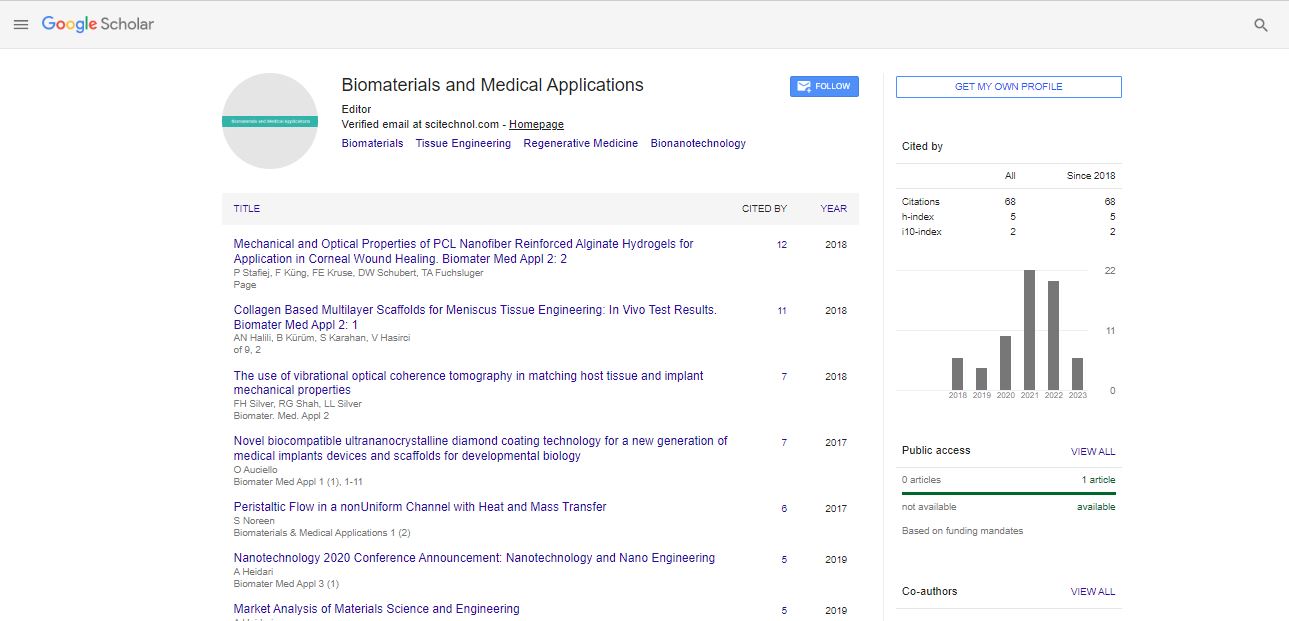Editorial, Bio Mater Med App Vol: 5 Issue: 4
Bio Electrodes and Biosensors
Balasubramanian Kandasubramanian*
Department of Metallurgical and Materials Engineering, Defense Institute of Advanced Technology (DU), Pune, Maharashtra, India
*Corresponding author: Balasubramanian Kandasubramanian, Department of Metallurgical and Materials Engineering, Biomaterials Research Laboratory, Defense Institute of Advanced Technology (DU), Pune, Maharashtra, India; E-mail: meetkbs@gmail.com
Received date: 01 July, 2021; Accepted date: 16 July, 2021; Published date: 25 July, 2021
Keywords: DNA, organelles, microorganisms, cells.
Introduction
Electrodes are sensors used to transmit information into or out of the body and are mainly applied in cardiology and neurology applications. Surface or transcutaneous electrodes used to monitor or measure electrical events in the body. A biosensor uses biological molecules, tissues, organisms to measure chemical or biochemical concentrations. Biosensors can be used in many medical and nonmedical applications. Biomedical sensors detect simple physical parameters like blood pressure or temperature to blood glucose. Biosensors works by changing the pH, ions, blood gases (O2, CO2 and etc.), drugs, hormones, proteins, viruses, bacteria, tumors and etc. Bio electrodes are devices used to produce or measure electrical activity in the body for electrophysiological stimulation or monitoring. This chapter will focus on electrodes for use in stimulation. Stimulation of electrically excitable tissue is achieved by establishing electrical fields in the tissue, using electrodes. These electrodes transduce electrons (the charge carrier for the electrical circuitry used in therapeutic stimulation devices) to ions (the charge carrier in the body), allowing electric charge to be injected into tissue. The materials used for these electrodes are integral to ensuring that this charge injection occurs safely and effectively. See also Chapter II.5.10, which addresses some aspects of bio electrodes using a different and complementary approach. Bio electrodes are devices that send an electrical signal to the body. Biosensors are devices that detect certain biochemical signals and convert them to electrical signals that can be measured. Biosensors are made of a transducer with a biologically active molecule. The biologically active molecule responds to the biochemical signal and relays that response to the transducer. Bio electrodes and sensors can be on the body surface or implanted. Implanted electrodes and sensors have many more needs for compatibility than the surface ones. Bio electrodes are commonly made of metals of high electrical conductivity. A common metal is stainless steel due to its low reactivity when in contact with the body. In some cases, copper, gold or platinum is used. Copper needs to be coated in the body as it reacts to the biochemical conditions in the body. Biosensors are made of a transducer with a biologically responsive material. The biologically active material responds to a certain biochemical factor which it wants to detect. This reaction in turn causes a slight change in the material, which also affects a piezoelectric material that makes up the transducer. The slight change in the materials causes a small electrical signal to be transmitted and measured. This is how the device measures the amount of a substance that is present. The transducers can be made of pH- or ion-selective electrodes, thermistors, optical fibres, or piezoelectric crystals. The biologically active material is what really makes the biosensor function. Materials that have been used as the biologically active materials include enzymes, antibodies, DNA, organelles, microorganisms, cells, etc. Each of them can be selected or modified to react specifically to certain biochemical signals. Purified enzymes are commonly chosen because they are specific in their reaction to the factors of interest. Biosensor materials must be able withstand bodily factors, such as temperature, pH, movement and chemically reactive substances while still functioning. There is a new trend in using nanomaterial’s as biosensors. They include grapheme, carbon nanotubes, nanowires, quantum dots and Nano composites. They have structures that allow them to be modified to detect certain biological factors. Their sensitivity, response time, stability and specificity make them promising materials for future biosensors. Thus, oxidative and acidic treatments have proven to be simple and cheap methods for enhancing the electro catalytic performance of enzyme-based FCF electrodes, which is crucial for feasible applications in miniaturized and implantable BFCs and biosensors.
